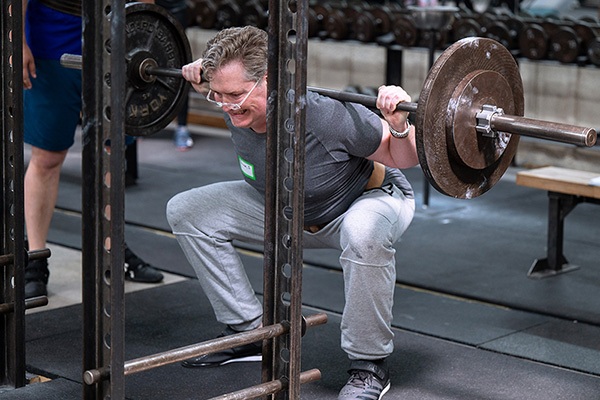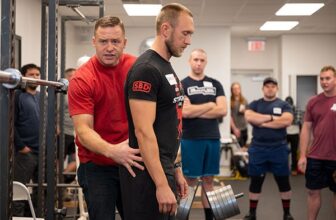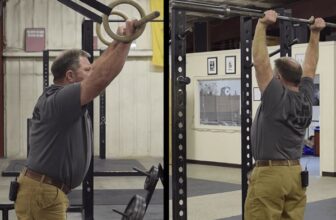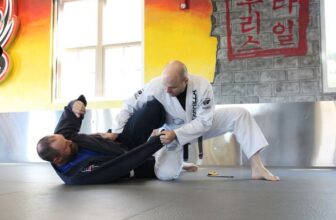
[adinserter block=”2″]
I have been a health enthusiast for
decades and recently started barbell training. I also have recently
experienced some musculoskeletal issues that required medical
attention. My doctor’s first response was, “Stop training with
barbells.” I did not care for this response, and will explain more
on this later. However, this experience did raise the question about
barbell training and the safety for seniors. I did some research and
will summarize what I have learned.
Coincident with my medical issues, I
have been able to spend some time with my elderly father-in-law. He
is an amazing man. He is kind and caring. He served in WWII in the
10th Mountain Division. He always has a smile! I have known him for
20 years and he is consistently a great person. He is healthy but I
have noticed he is slowing down, particularly these last couple of
years. He cares for his wife who has limited mobility and dementia.
Because of that he is house bound and no longer gets much exercise.
I have noticed it is harder for my
father-in-law to get out of a chair or into a car. Recently we got
him a walker to help him stabilize and now he walks a bit almost
every day. It is clear to me that he has lost strength and his
balance is shaky at times. I assume this is related to strength loss.
Rippetoe and Baker discuss the stress/recovery/adaptation cycle,
which is dependent on stress to cause change.[1] Unfortunately, my
father-in-law’s current living situation is stressful – not all
stresses produce a beneficial adaptation – and his body has adapted
through atrophy. However, even after a couple of weeks of exercise, I
see his walking improving, and he sets new goals for each walk.
Yesterday, I saw him walking in the house carrying his cane,
not using it – a clear sign of improvement. He also has improved
spirits. What does this have to do with strength and aging? Short
answer, everything!
A bit of background, for context: I am
nearly 71 and have been committed to exercise most of my adult life.
I am a retired U.S. Naval officer who spent 24 years in the submarine
force. I am also an educator spending my career in military training,
corporate education, and higher education. I am fascinated with
learning and I strive to learn new things regularly. My son-in-law
introduced me to the Starting Strength method 9 months ago. He is a
strength and conditioning expert who has worked with the Navy Seals
and is now working with the US Army on their fitness programs. Also,
I recently started working with a Starting Strength Coach, and that
has made all the difference in how I train.
Recently, my coach and I were talking
about research on older folks and barbell training, and we concluded
there is not much out there. I used the search term “weightlifting
for seniors research study” to identify potential articles. I then
focused on articles/studies by reputable institutions, universities,
and government institutions. “Reputable” does not necessarily
mean these studies are valid and reliable, statistically. Any
researcher can choose a sample group that is biased in some way, or
not study the experimental intervention long enough, or commit many
other research errors. On the other hand, these researchers may have
gleaned valuable information. The studies I found all have similar
conclusions. One last caveat: I did not do a complete literature
search, rather more a sample of current research.
Does strength training help older
adults? Mayer, et al. concluded “Progressive strength training in
the elderly is efficient, even with higher intensities, to reduce
sarcopenia, and to retain motor function.”[2] This study set the
stage for the importance of strength training by explaining the rate
of muscle loss with aging. The authors conclude that muscle loss is
fairly linear until the 6th decade of life, and then shows a
nonlinear decline of as much as 30% in the 8th decade. The result of
this, according to these authors: “Functional losses in strength
and balance capacity, and increasing gait uncertainties are the
result. The risk of acute problems owing to falls and injuries and
chronic recurrent and degenerative illnesses rises.”[2]
I clearly see this decline in strength
and balance in my father-in-law. His ability to pick up his feet has
declined significantly, and he often trips on small objects. With
coaching he is relearning to pick up his feet, and with practice
he is getting stronger and able to do this for longer walks.
I must admit that when I first started
to do the Starting Strength program, on my own, I was shocked to see
how little weight I could press. I suspected that I was weaker but
that was an understatement! I had been doing kettlebell training for
some time. When I think back to my days in the Navy, and the arduous
work we would do moving torpedoes, repairing torpedo tubes and many
other hard jobs, I felt invincible and strong. My kettlebell training
was with low weights and high reps, clearly not enough stress to
facilitate a strength adaptation. Once I started using Starting
Strength I began to see real strength gains. However, I suspected my
technique was not ideal. Not until I got some coaching on the proper
lifting technique did I see real progress and a feeling of strength
coming back.
Mayer, et al. was a literature review
of 1500 research studies, from which 33 were chosen. From these
studies the researchers concluded that seniors should work with
weight training 3-4 times per week and progress the weight being
used. “Muscle mass can be increased through training at an
intensity corresponding to 60% to 85% of the individual maximum
voluntary strength. Improving the rate of force development requires
training at a higher intensity (above 85%), in the elderly just as in
younger persons.”[2]
In another article, Seguin and Nelson
found: “Done regularly (e.g., 2 to 3 days per week), these
exercises build muscle strength and muscle mass and preserve bone
density, independence, and vitality with age. In addition, strength
training also has the ability to reduce the risk of osteoporosis and
the signs and symptoms of numerous chronic diseases such as heart
disease, arthritis, and type-2 diabetes, while also improving sleep
and reducing depression.[3]
What is intriguing about the Sequin and
Nelson article is the comprehensiveness of the benefits of strength
training. I would add there is a great psychological benefit. In my
experience, it is clear how good I feel after a good training
session. I feel stronger, more alive, and I look forward to the next
training session. I am a few weeks into my second round of Novice
Linear Progression – this time guided by a Starting Strength Coach
– and my strength and confidence are improving. I am not worried
about injuring myself, and seeing gains each session just plain feels
good.
The seriousness of sarcopenia is laid
out in an article titled “Strength training in elderly: An useful
tool against sarcopenia.”[4] Here the authors argue that strength
decline is a “public health problem.”[4] They argue that frail
seniors often are given low intensity exercises, but resistance
training is more effective. Remember that our bodies react to stress
and adapt as the stress demands. There is a clear downward cycle like
my father-in-law was experiencing. The stress of sitting all day and
only walking around his small house was a stress that his body
adapted to by becoming frail.
Why do we really want to get stronger?
We want to continue to do things that make our life enjoyable and to
stay independent as long as possible, which means living longer.
“Older adults who strength trained at least twice a week had 46
percent lower odds of death for any reason than those who did not.
They also had 41 percent lower odds of cardiac death and 19 percent
lower odds of dying from cancer.”[5]
My personal strength journey is about
getting stronger to allow me to do the things I enjoy. That may sound
obvious, but I offer that I am an active guy and want to stay active
for many years. I play golf nearly every day. I am an avid downhill
skier and skied 25+ days this last winter. I cycle and scuba dive
also. All of these require strength.
Here is positive proof of the benefit
of strength training for me. I had been doing Starting Strength’s
NLP about 3 months before ski season this last winter. My stamina and
strength were significantly improved. I skied more mogul runs this
past season than all the years prior and I did not have fatigued
legs. I had more stamina than most of the guys in the ski club. It
was an amazing difference.
The common sense of strength is what
many folks miss in my opinion. Many accept the decline as part of the
norm, not knowing and being willing to take action to arrest the
decline. I live in a 55+ community and I am shocked how many guys are
exhausted and need a nap after a round of golf – and we ride in
golf carts. After golf, folks sit around and discuss their aches and
pains. When I try to tell them that we can get stronger and feel
better, they want no part of that discussion. The advantage of doing
the “big lifts” is so clear to me. Balance, whole body
involvement, awareness of your body in space are all real-world
strength requirements.
Strength training, particularly the
Starting Strength method, has helped me in many ways. It has engaged
my desire to learn. Yesterday I trained and was paying attention to
my form, and during rest periods watching others train. I have a cue
card I made to help me with areas I need to improve. For example, a
squat is not that complicated but there are key things you must do to
get the most out of the lift and not injure yourself. I have read
both of Rippetoe’s books multiple times and listened to each of his audio books (I am a slow learner). These books have a lot of
content. I am clear that I need to study, practice, and get good
coaching. The result is I have fewer aches and pains, greater
endurance doing hard things, and I just feel stronger. Guys like to
feel strong.
I must share a funny experience that I
had recently at my SS affiliated gym. I went in and there were three
women and I training during that time. One lady looked about my age
and the other two were younger. I was shocked by the amount of weight
they were squatting, far greater than me. I was almost embarrassed by
the amount of weight I had on the bar compared to these strong
ladies. I was to learn that they hold state records and have been
training for some time. I came away from that experience with hope,
after I got over my ego bruise.
One of the fascinating things in my
mini-research review is the absence of any study that suggests
strength training is harmful to older folks. The straightforward
evidence is that everyone should do strength training. I did an
additional search looking for evidence that weightlifting can be
harmful to seniors and did not find a single article. That contrasts
what many Doctors and Physical Therapists seem to believe.
A couple of months ago I developed some
hip pain. I went to a sports orthopedic facility and saw the doctor
who had treated me for ailments in the past. Without any diagnostic
testing (MRI) he declared that I had a torn hip labrum and that I
needed to stop doing squats. He told me to do leg presses! I laid off
for a week and went back to squatting. I returned and told him the
pain was diminishing, and he was still insistent that I should not do
squats. I asked if we should do an MRI, and he begrudgingly agreed.
The MRI showed no tears, some bursitis. I sent the MRI disc to the
doctor and now he will not return my calls. I am pain free and
starting to set some new PRs in the NLP. Clearly, he did not like my
pushing back. I will not be seeing him again. There are clear
instances when we should follow doctor’s advice, but we have a
right and a responsibility to advocate for ourselves.
I am sure many folks would say that my
100-year-old father-in-law should take it easy. Well, that is not how
you get to be 100 years old. He had always been active. He is now
walking 5 days a week and setting new distance PRs, which he loves to
tell people about. We are going to introduce some resistance
training. He is motivated and just needs a little help to start
training.
I had to learn that like my
father-in-law I needed a little help with learning to train properly.
I tried to learn the main lifts of the SS program and did learn a lot
but learning and performing are quite different. I have only had a
couple of coaching sessions and I am already much better at the
lifts. My squat depth was well above parallel, as an example. I now
can feel the proper depth and know this is making me stronger. All
the other lifts had errors also. I am confident that through
continued coaching, I will improve.
I am not suggesting there is no
difference in how seniors should barbell train. On the contrary, as
clearly laid out in Practical Programming for Strength Training 3rd Edition one must design a program based on individual
factors.[1] In the Starting Strength method there is a focus on a
three phased approach that includes stress, recovery, and adaptation.[6] One difference is recovery time for seniors. For example, we may
need more recovery time, like 72 hours. This is just one example. A
well-designed personal program is needed to see the best benefits and
prevent injury. While I am new at this, having a Starting Strength
coach allows for the proper execution of the program. I believe that
I will see faster and better progress as the result of having a
coach.
Strength and aging are connected
significantly. Getting and staying strong has innumerable benefits,
as the literature cited in this paper supports. And my practical
experience demonstrates the effectiveness of strength training. I
want to thank my coach, Cody Annino, and all the SSCs who have
commented on my questions, and of course Mark Rippetoe for
championing this effort!
References
- Rippetoe and Baker (2021). Practical
Programming for Strength Training, 3rd Edition - Mayer F, Scharhag-Rosenberger F,
Carlsohn A, Cassel M, Müller S, Scharhag J. The intensity and
effects of strength training in the elderly. Dtsch Arztebl Int. 2011
May;108(21):359-64. doi: 10.3238/arztebl.2011.0359. Epub 2011 May 27.
PMID: 21691559; PMCID: PMC3117172. - Seguin R, Nelson ME. The benefits of
strength training for older adults. Am J Prev Med. 2003 Oct;25(3
Suppl 2):141-9. doi: 10.1016/s0749-3797(03)00177-6. PMID: 14552938. - Cannataro R, Cione E, Bonilla DA,
Cerullo G, Angelini F, D’Antona G. Strength training in elderly: An
useful tool against sarcopenia. Front Sports Act Living. 2022 Jul
18;4:950949. doi: 10.3389/fspor.2022.950949. PMID: 35924210; PMCID:
PMC9339797. - Abbasi, Jenifer (2022). Strength
training helps older adults live longer | Penn State University
(psu.edu). - Mark Rippetoe (2011). Starting
Strength: Basic Barbell Training, 3rd edition.
Discuss in Forums
[adinserter block=”2″]
Credit : Source Post






